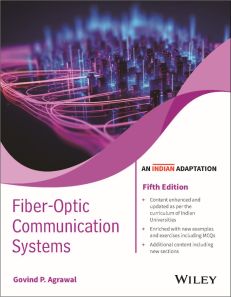Fiber - Optic Communication Systems, 5ed (An Indian Adaptation)
ISBN: 9789357461245
648 pages
For more information write to us at: acadmktg@wiley.com

Description
Fiber-Optic Communication Systems, 5th edition delivers brand-new updates and developments in the science of fiber-optic communications. The book contains substantial additions covering the topics of coherence detection, space division multiplexing, and more advanced subjects. You’ll learn about topics like fiber losses, dispersion, and nonlinearities, as well as coherent lightwave systems. The latter subject has undergone major changes due to the extensive development of digital coherent systems over the last decade. Space-division multiplexing is covered as well, including multimode and multicore fibers developed in just the last ten years.
Preface
1 Introduction
1.1 Historical Perspective
1.2 Basic Concepts
1.3 Optical Communication Systems and Components
1.4 Applications and Challenges
2 Optical Fibers
2.1 Geometrical-Optics Description
2.2 Wave Propagation
2.3 Dispersion in Single-Mode Fibers
2.4 Dispersion-Induced Limitations
2.5 Fiber Losses
2.6 Nonlinear Optical Effects
2.7 Fiber Design and Fabrication
3 Optical Transmitters
3.1 Semiconductor Laser Physics
3.2 Single-Mode Semiconductor Lasers
3.3 Semiconductor Laser Characteristics
3.4 Modulation Techniques
3.5 Light-Emitting Diodes
3.6 Transmitter Design
4 Optical Receivers
4.1 Basic Concepts
4.2 Common Photodetectors
4.3 Receiver Design
4.4 Receiver Noise
4.5 Coherent Detection
4.6 Receiver Sensitivity
4.7 Sensitivity Degradation
4.8 Receiver Performance
5 Lightwave Systems
5.1 System Architectures
5.2 Design Guidelines
5.3 Long-Haul Systems
5.4 Sources of Power Penalty
5.5 Forward Error Correction
5.6 Optical Network Design Using Computer-Aided Design
6 Multichannel Systems
6.1 WDM Systems and Networks
6.2 WDM Components
6.3 System Performance Issues
6.4 Time-Division Multiplexing
6.5 Subcarrier Multiplexing
6.6 Code-Division Multiplexing
7 Loss Management
7.1 Compensation of Fiber Losses
7.2 Erbium-Doped Fiber Amplifiers
7.3 Raman Amplifiers
7.4 Optical Signal-To-Noise Ratio
7.5 Electrical Signal-To-Noise Ratio
7.6 Receiver Sensitivity and Q Factor
7.7 Role of Dispersive and Nonlinear Effects
7.8 Periodically Amplified Lightwave Systems
8 Dispersion Management
8.1 Dispersion Problem and Its Solution
8.2 Dispersion-Compensating Fibers
8.3 Fiber Bragg Gratings
8.4 Dispersion-Equalizing Filters
8.5 Optical Phase Conjugation
8.6 Advanced Techniques
8.7 Electronic Dispersion Compensation
9 Control of Nonlinear Effects
9.1 Impact of Fiber Nonlinearity
9.2 Solitons in Optical Fibers
9.3 Pseudo-linear Lightwave Systems
9.4 Management of Nonlinear Effects
10 Coherent Lightwave Systems
10.1 Coherent Transmitters
10.2 Coherent Receivers
10.3 Noise and Bit-Error Rate
10.4 Sources of Performance Degradation
10.5 Management of Nonlinear Effects
10.6 Digital Signal Processing
10.7 Experimental Progress
10.8 Channel Capacity
11 Space-Division Multiplexing
11.1 SDM Technique
11.2 Modes of Optical Fibers
11.3 SDM Components
11.4 Modeling of SDM Systems
11.5 Experimental Progress
12 Advanced Topics
12.1 Optical Signal Processing
12.2 Wavelength Conversion
12.3 Ultrafast Optical Switching
12.4 Optical Regeneration
12.5 Nonlinear Frequency-Division Multiplexing
12.6 Optical Sensors
12.7 Hybrid Fiber-FSO Systems
Problems
References
A System of Units
B Acronyms
C Formula for Pulse Broadening
D Nyquist Pulses
References
Index

